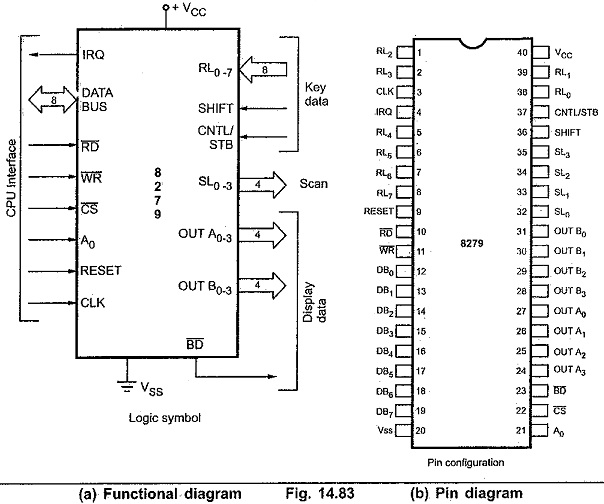Pin Diagram of 8279:
Fig. 14.83 shows functional and pin diagram of 8279. It is a 40 pin device and looking at Fig. 14.83 (a) we can see that these pins are divided in four functional groups :
-
CPU interface
-
Key data
-
Display data
-
Scan
CPU Interface Pins:
As shown in Fig. 14.83 (a), it consists of 8-bit data bus, RD, WR, A0, CS, RESET, CLK and IRQ lines.
DB0-DB7 : Bi-directional data bus :
All data, commands and status information between the CPU and the 8279 are transmitted on these bi-directional 8-bit data bus.
RD : Read:
It is an active low signal. When RD signal is low CPU reads the contents of selected register (display RAM, status register or FIFO RAM) from 8279; depending on the type of command and the status of the A0 signal.
WR : Write:
It is an active low signal. When WR signal is low, CPU loads the data into selected register (control register or display register) depending on the status of A0 signal.
A0 : Address line:
When A0 is high, signals are interpreted as a command or status. When A0 is low, signals are interpreted as a data.
CS : Chip select :
It is an active low signal. When low, enables the communication between CPU and 8279.
RESET : A high signal on this pin resets 8279. After being reset 8279 is configured in the following mode.
-
Sixteen 8-bit character display-left entry
-
Encoded scan keyboard- 2 key lockout
-
The program clock prescaler is set to 31.
CLK : This signal is usually driven by the system dock and used to generate internal timings.
IRQ : Interrupt Request :
This signal is used to implement interrupt driven input system. In scanned keyboard mode, the interrupt line goes low when there is data in the FIFO/sensor RAM. The interrupt line goes low with each FIFO/sensor RAM read and returns high if there is still information in the RAM. In sensor matrix mode, the interrupt line goes high whenever a change in a sensor is detected. The IRQ line is cleared by the first data read operation if the auto increment flag is set to zero, or by the End interrupt command if the Auto-increment flag is set to one. The interrupt feature of Pin Diagram of 8279 eliminates the need of polling the keyboard.
Keyboard Data:
This group consists of return, SHIFT and CNTL/STB lines.
RL0-RL7 : Return lines : These input lines are used to interface matrix keyboard. These lines have active internal pullups which keep their status high. When the key from, the matrix keyboard is pressed corresponding return line goes low. In the strobed input mode these lines are used as 8 input lines.
SHIFT : It is a special key input line. Its status is stored along with the key position on the key closure in the scanned keyboard modes. It has an active internal pullup to keep it high until, a switch closure pulls it low.
CNTL/STB : Control/strobe
For scanned keyboard mode this line is used as a control input. Like SHIFT key, its status is stored along with the key position on the key closure. It also has an active internal pullup to keep it high until a switch closure pulls it low.
In the strobed input mode this line is used as a strobe input. When activated, loads the status of keyboard into the FIFO RAM.
Display Data:
This group consists of OUT A3-A0, OUT B3-B0 and BD lines.
OUT A3-A0 and OUT B3-B0 : These two four bit output ports; which can be considered as an one 8-bit port. These are used for sending data to display drivers from display RAM and connected to the segment inputs of 7 segment display or row inputs of dot matrix displays. These lines are synchronized to the scan lines (SL0-SL3) for multiplexed digit display. In other words we can say that when the data on the scan lines is 0000, ports will have data from register 0 of display RAM and when the data on the scan lines is 1111, ports will have data from register 15 of display RAM. The two 4-bit ports can be blanked independently.
BD : Blank Display :
This is an active low output used to blank the display during digit switching or by a display blanking command.

